Welcome to our comparison of BLUETTI AC180 vs EcoFlow DELTA 2, where we will analyze the specifications and features of each model to guide you to the best choice for your portable power needs. Both the BLUETTI and EcoFlow models are very evenly matched across the board, with similar features and specifications. For this reason, in this article we aim to highlight the subtle differences that might tip the scales in favor of one over the other based on your specific requirements.
Both models are available as standalone portable power stations and can be integrated into broader solar generator systems, which include the core power station complemented by a selection of compatible solar panels.
For a more general comparison of the BLUETTI and EcoFlow brands, you might be interested in reading our brand comparison article.
In addition to their solar panel and smart devices range, EcoFlow’s product line-up is categorised into two main series: the DELTA Series and the RIVER Series. The DELTA series is designed for those requiring robust power solutions, featuring models with higher capacities and outputs. On the other hand, the RIVER series caters to users looking for more affordable options with moderate power needs.
EcoFlow’s DELTA range consists of the DELTA, DELTA Mini (now discontinued), DELTA Max, DELTA Pro, DELTA 2, DELTA 2 Max, DELTA Pro Ultra, and DELTA Pro 3 (where ‘Pro’ trumps ‘Max’). Click here to see the full range of DELTA products.
Their RIVER series consists of the RIVER Pro, RIVER 2, RIVER 2 Pro, and RIVER 2 Max. Click here to see the full range of RIVER products.
We always recommend purchasing BLUETTI and EcoFlow products directly from their official websites or Amazon stores. While there are many reputable wholesalers and third-party sellers, buying from these sources may invalidate your warranty and make it more challenging to contact customer support. For this reason, any and all links in this article will take you straight to the brands’ websites or official Amazon stores.
For more information on each brand’s warranty policies, visit EcoFlow and BLUETTI‘s Warranty Policy webpages.
BLUETTI AC180 vs EcoFlow DELTA 2
BLUETTI AC180
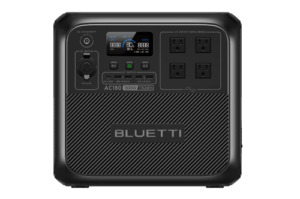
Price (UK): £699 (£1,099 full price)
Price (US): $799 ($999 full price)
Power (W): 1,800
Capacity (Wh): 1,152
Cell chemistry: LiFePO₄
Weight: 37 lbs (17 kg)
Dimensions: 13.4 x 9.7 x 12.5 in (340 x 247 x 317 mm)
Warranty: 5 years
Customer rating: ⭐⭐⭐⭐⭐ (255)
Charging Options: AC, Solar, Car. Life Cycles: 3,500+ cycles to 80% original capacity. AC Charging: 1.3-1.8 hours. Solar Charging: 2.8-3.3 hours (with optimal conditions and 500W input). Car Charging: 6.3-12.5 hours. Scalability: Not expandable, but can be charged with B80 , B230, B300 batteries.
EcoFlow DELTA 2
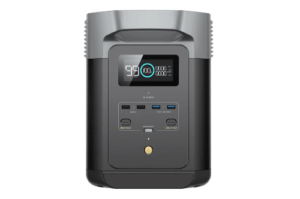
Price (UK): £799 (£899 full price)
Price (US): $529 ($999 full price)
Power (W): 1,800
Capacity (Wh): 1,024
Cell chemistry: LiFePO₄
Weight: 27 lbs (12 kg)
Dimensions: 15.7 x 8.3 x 11 in (400 x 211 x 281 mm)
Warranty: 5 years
Customer rating: ⭐⭐⭐⭐⭐ (392)
Charging Options: AC, Solar, Car. Life Cycles: 3000 cycles to 80+% capacity. AC Charging: Charges 80% in ~50 minutes; full charge in <2 hours (X-stream Fast Charge). Solar Charging: 3-6 hours. Car Charging (12V): 25 hours. Scalability: Expandable with DELTA 2 Smart Extra Battery, DELTA Max Smart Extra Battery or DELTA 2 Max Smart Extra Battery.
Comparison Overview Chart: BLUETTI AC180 vs EcoFlow DELTA 2
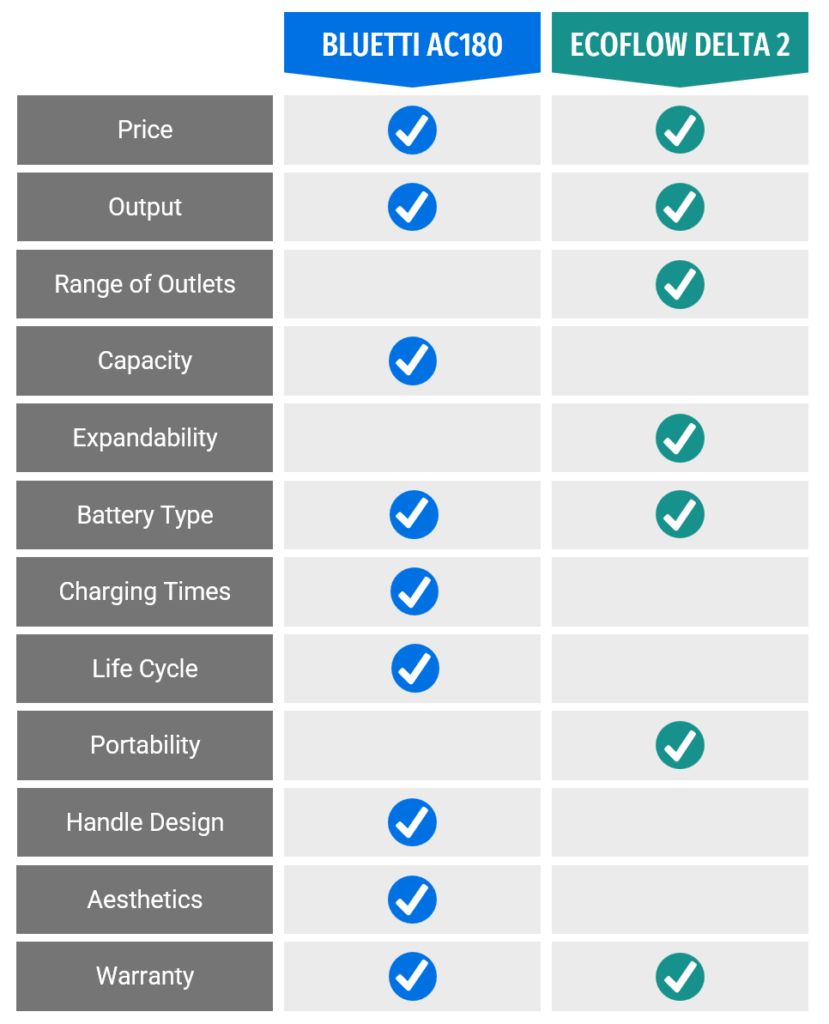
Price
Both the BLUETTI AC180 and EcoFlow DELTA 2 have the same standard pricing of USD $999, however the BLUETI AC180 is often on sale for $799, whilst the EcoFlow DELTA 2 can often be found at the lower price of $529.
Output (W)
Both the BLUETTI AC180 and the EcoFlow DELTA 2 have the same continuous output of 1800W output, and the same surge output of 2700W (also referred to as ‘Power Lifting Mode’ by BLUETTI) for higher-demand appliances.
The key difference between BLUETTI AC180 vs EcoFlow DELTA 2 lies in the EcoFlow DELTA 2’s ‘X-Boost technology,’ meaning it prevents overloading from devices up to 2200W.
Outlet options
The BLUETTI AC180 includes 2x AC outlets (240V/7.5A), 1x USB-C outlet (100W max), 4x USB-A outlets (5V/3A), and 1x DC5521 outlet (12V/10A), alongside a car outlet and a 15W max wireless charging pad.
In contrast, the EcoFlow DELTA 2 provides 4x AC outlets (220V-240V), 2x USB-C outlets (100W max), 2x USB-A outlets, and 2x DC5521 outlets (12V/3A, 38W max), alongside a car outlet, but does not feature wireless charging.
Capacity (Wh)
The BLUETTI AC180 has a capacity of 1152Wh, and cannot be scaled up with additional battery units. On the other hand, whilst the EcoFlow DELTA 2 has a lower base capacity of 1024Wh, it does offer expandability of up to 3072Wh total when connected to additional battery units. This feature allows for significant capacity enhancement, ensuring longer usage and greater flexibility in power management.
The following batteries are supported by the EcoFlow DELTA 2 for expanding capacity:
(Please note: whilst the BLUETTI AC180 does not have scalability with additional battery units, it CAN be charged by additional batteries through Power Bank Mode. Compatible batteries include the B80, B230, or B300 batteries. The DC7909 cable is required for connecting the B80 battery, while the P090D cable is required for the B230/B300 batteries.)
Battery
Both the BLUETTI AC180 and the EcoFlow DELTA 2 utilize LiFePO₄ (lithium iron phosphate, or LFP) batteries, which are renowned for their safety and longevity. Whilst slightly heavier than alternatives, these batteries provide a stable power source and are less prone to thermal runaway compared to traditional lithium-ion batteries. The use of LiFePO₄ technology in both units ensures a more durable and reliable performance, making both them excellent choices for extended use in various settings.
Recharging Options and Speed
The BLUETTI AC180 has fast recharging capabilities, recharging from 0-80% in 45 minutes via 1440W AC input, and achieving a full recharge within 1.3-1.8 hours. It can also be recharged fully in under 3 hours via solar panels (with a maximum 500W solar input) in ideal conditions.
The EcoFlow DELTA 2 has very similar charging times, recharging from 0-80% in 50 minutes, and completing a full recharge in under 2 hours. Its solar charging capabilities are similarly efficient, with the potential to fully charge in 3-6 hours depending on solar conditions and panel setup.
Both the BLUETTI AC180 and EcoFlow DELTA 2 can be recharged via AC, car, or solar – both supporting a 12V/24V car input, and maximum 500W solar input.
Charge Life Cycle
Both models have a very similar life cycle, although the BLUETTI AC180 has a slight edge with 3,500+ cycles to 80%, compared to the EcoFlow DELTA 2 at 3,000+ cycles to 80%.
Portability
The BLUETTI AC180 weighs in at 35 lbs (16 kg), making it noticeably heavier than the EcoFlow DELTA 2, which weighs 27 lbs (12 kg).
The AC180 and DELTA 2 are more similarly matched in terms of size, with the AC180 measuring 13.39 x 9.72 x 12.48 inches (340 x 247 x 317 mm) and the DELTA 2 measuring 15.7 x 8.3 x 11 inches (400 x 211 x 281 mm).
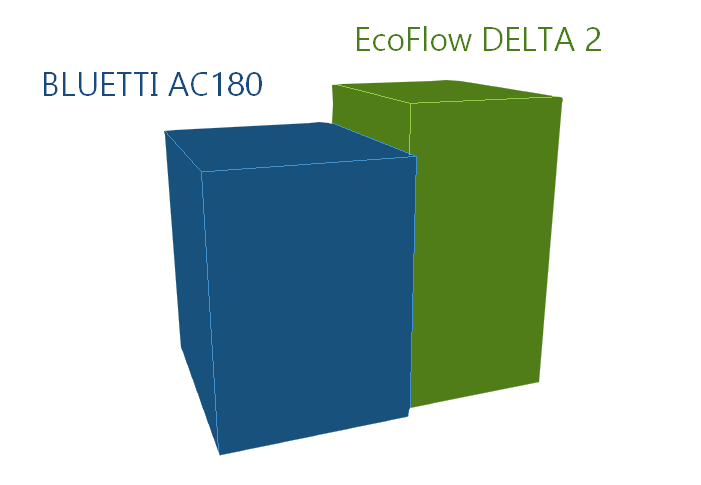
However, whilst weight and size are important factors when it comes to portability, it is also important to consider handle design. Whilst both power stations have two handles on the top of the units, the BLUETTI AC180’s handles are much more compact than the DELTA 2’s, whose handles protrude out on either side.
Personally, we prefer the design of the handles on the AC180 as it makes it much easier for things like packing inside a car or storing when not in use – that and the build of the handles just feels a little sturdier than on the DELTA 2.
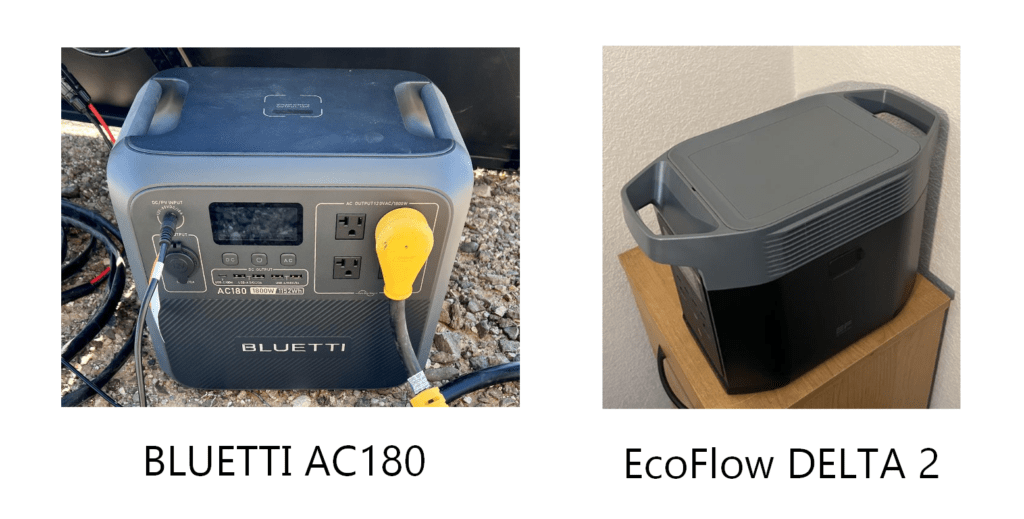
App Control and Connectivity
Both the BLUETTI AC180 and EcoFlow DELTA 2 offer remote control and connectivity through their respective smartphone apps. Both models’ apps offer control via both Wi-Fi and Bluetooth, and provide options for remote control and real-time monitoring, including insights into battery status, power usage, and the option to control settings such as charging limits and port activation.
Generally, reviews of both models have positive sentiments towards these apps, which are described as being convenient and offering good functionality. The ability to interact with their power stations is particularly useful in outdoor or backup scenarios, although some users noted occasional connectivity issues which required a device restart or app refresh to resolve.
Warranty
Both the BLUETTI AC180 and the EcoFlow DELTA 2 have the same 5-year warranty, which is a significant length of time for portable power stations (many units only have 2-3 years, including other models from both the BLUETTI and EcoFlow brands).
Please note that this warranty is for products purchased from the BLUETTI and EcoFlow websites directly, and may not apply to products purchased from third-party websites, including Amazon. It is for this reason that we always encourage buyers to purchase directly from the brand’s website.
Full Comparison Table (BLUETTI AC180 vs EcoFlow DELTA 2)
BLUETTI AC180 vs EcoFlow DELTA 2 specifications
| Feature | BLUETTI AC180 | EcoFlow DELTA 2 |
| AC Output (W) | 1800 | 1800 |
| Surge Power (W) | 2700 | 2700 |
| Battery Capacity (Wh) | 1152 | 1024 |
| Expandable Capacity | No | Yes |
| Battery Type | LiFePO₄ | LiFePO₄ |
| Life Cycles | 3500+ cycles to 80% | 3000+ cycles to 80% |
| AC Outlets | 2x (240V/7.5A) | 4x (220V-240V) |
| USB-A Outlets | 4x (5V/3A) | 2x |
| USB-C Outlets | 1x (100W max) | 2x (100W max) |
| DC5521 Outlets | 1x (12V/10A) | 2x Outlets – 12V/3A, 38W Max |
| Car Outlets | 1x | 1x |
| Wireless Charging Pad | 1x (15W max) | None |
| Solar Charging | 500W Max | 500W max |
| AC Charging | 1440W max (Turbo Charging) | 1200W max (X-stream Fast Charge) |
| Car Charging | Yes | Yes |
| Weight (lbs) | 35 | 27 |
| Dimensions (in) | 13.39 x 9.72 x 12.48 | 15.7 x 8.3 x 11 |
| Smart App Control | Yes | Yes |
| Warranty | 5 years | 5 years |
Full comparison table for BLUETTI AC180 vs EcoFlow DELTA 2.
Customer Reviews
When it comes to customer reviews for the BLUETTI AC180 vs EcoFlow DELTA 2, both are currently averaging a very impressive 4.9/5. We aggregated the most common customer feedback for you to review below.
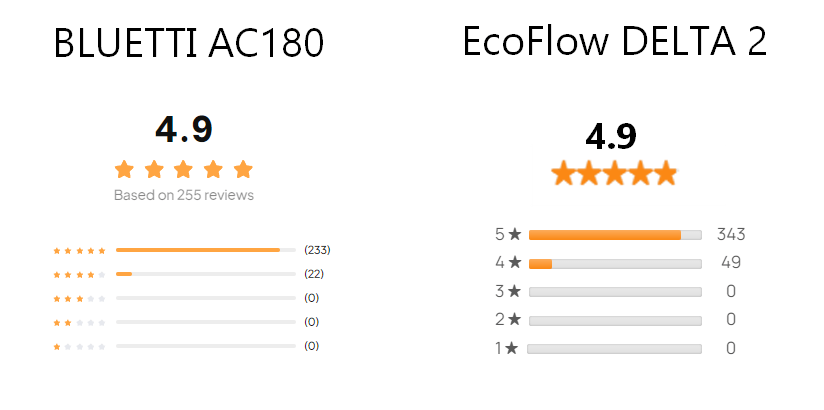
BLUETTI AC180: ⭐⭐⭐⭐⭐ (255)
- ✅ Versatility and performance: Customers were happy with the AC180’s ability to power a wide range of devices, from small appliances to demanding tools, as well as its high output and efficient charging capabilities across AC, solar, and DC sources.
- ✅ Portability and design: The manageable weight and compact design of the AC180 are frequently mentioned in reviews, making it ideal for outdoor activities like camping and tailgating, as well as for emergency home use.
- ✅ User-friendly interface and app control: The intuitive app that allows for remote monitoring and control was also a plus for many customers.
- ❌ Heavy weight: While generally considered portable, a few users felt the AC180 was still a bit heavy or bulky for certain uses (especially for those with physical limitations).
- ❌ Expansion limitations: Some users were disappointed that the unit doesn’t support direct expansion with certain batteries, limiting its out-of-the-box expandability.
- ❌ Operational noise: A few minor issues were about the noise level during high-power output or rapid charging, which some found louder than expected.
- ❌ Power management under extreme loads: There were reports of the unit overheating when pushed to its maximum capacity continuously, though it recovered without any permanent issues.
EcoFlow DELTA 2: ⭐⭐⭐⭐⭐ (392)
- ✅ Portability and battery technology: Customers appreciate the Delta 2 for its compact size, lightweight design, and advanced LFP battery technology, which marks a significant upgrade from previous models and competing brands.
- ✅ Charging efficiency: The ability to fast charge via AC or solar for both the DELTA 2 and its extra battery is highly valued, along with the convenient app that allows monitoring and control over the charging process and power output.
- ✅ Power and expandability: Users are impressed with the Delta 2’s power output and its expandability feature, allowing an extra battery to significantly increase its capacity. This makes it versatile for a wide range of uses, from emergency backup power to outdoor activities.
- ❌ Minor power draining issue: One review mentioned the DELTA 2’s slight power drain over time when not in use, though a BMS reset was suggested as a solution, which seemed to resolve the issue for affected users.
- ❌ App connectivity issues: Some users reported frequent disconnections and the need to refresh the app to reconnect, along with challenges in reconnecting to the station after being away for an extended period.
- ❌ Fan noise: Some users commented that the fans can be quite loud, especially under full load, which could be disruptive in quieter settings.
- ❌ Stand-alone functionality of extra battery: Some users expressed a desire for the extra battery to function independently, for additional versatility.
Purchase Options for BLUETTI AC180 vs EcoFlow DELTA 2
The BLUETTI AC180 can be purchased in bundles with different solar panel models. All these options can be selected on the AC180’s product page:
Similarly, the EcoFlow DELTA 2 has the following options for purchase bundles, as well as optional add-ons:
(Considering the EcoFlow 800W Alternator Charger? Check out our guide to decide if it’s right for you.)
Conclusion: BLUETTI AC180 vs EcoFlow DELTA 2
So, which is the winner of BLUETTI AC180 vs EcoFlow DELTA 2?
It’s clear that both models are exceptional portable power stations – their extremely positive customer reviews serve as testament to that. They are equally matched in many of their specifications – both the AC180 and DELTA 2 have a maximum output of 1800W and surge capability of up to 2700W, and they both use durable LiFePO₄ ensuring long life cycles and a high safety profile.
If forced to make a decision of one model over the other, I would personally lean towards the BLUETTI AC180. This is largely due to my preference for BLUETTI’s overall product design (particularly the compactness of the handles, and the overall sleekness of the aesthetics), but also the battery’s slightly higher capacity. The main drawbacks are of course the AC180’s lack of scalability, and also its heavier weight than the DELTA 2, but in my opinion the more comfortable design of the BLUETTI’s handles makes up for its extra weight.
BLUETTI AC180 vs EcoFlow DELTA 2: Final thoughts
In summary:
- If you want a slightly lighter option for easier handheld portability: EcoFlow DELTA 2
- If the option of future expandability is important to you: EcoFlow DELTA 2
- If you want a greater range of outlets: EcoFlow DELTA 2
- If you want slightly faster charging times: BLUETTI AC180
- If handle comfort is particularly important to you: BLUETTI AC180
- If sleek aesthetics are important to you: BLUETTI AC180
- If cost is the most important factor to you: choose whichever is currently on sale!
Ultimately, whether you opt for the BLUETTI AC180 or the EcoFlow DELTA 2, you can’t go wrong. In either case, you’re choosing a top-tier power solution from two excellent and reliable brands – both models enjoy their popularity for a reason.
We hope this comparison of BLUETTI AC180 vs EcoFlow DELTA 2 has made your decision a bit easier!
For further reading, you might be interested in:
Solar Trek is all about breaking down information about solar-powered brands and products into a helpful, easily digestible format. All of our content is totally objective, aimed at helping you to make the best purchasing decisions for your solar needs. If you click our links and make a purchase, we may earn some commission at absolutely no extra cost to you, but this does not interfere with our goals of providing 100% helpful, informative, and objective information.


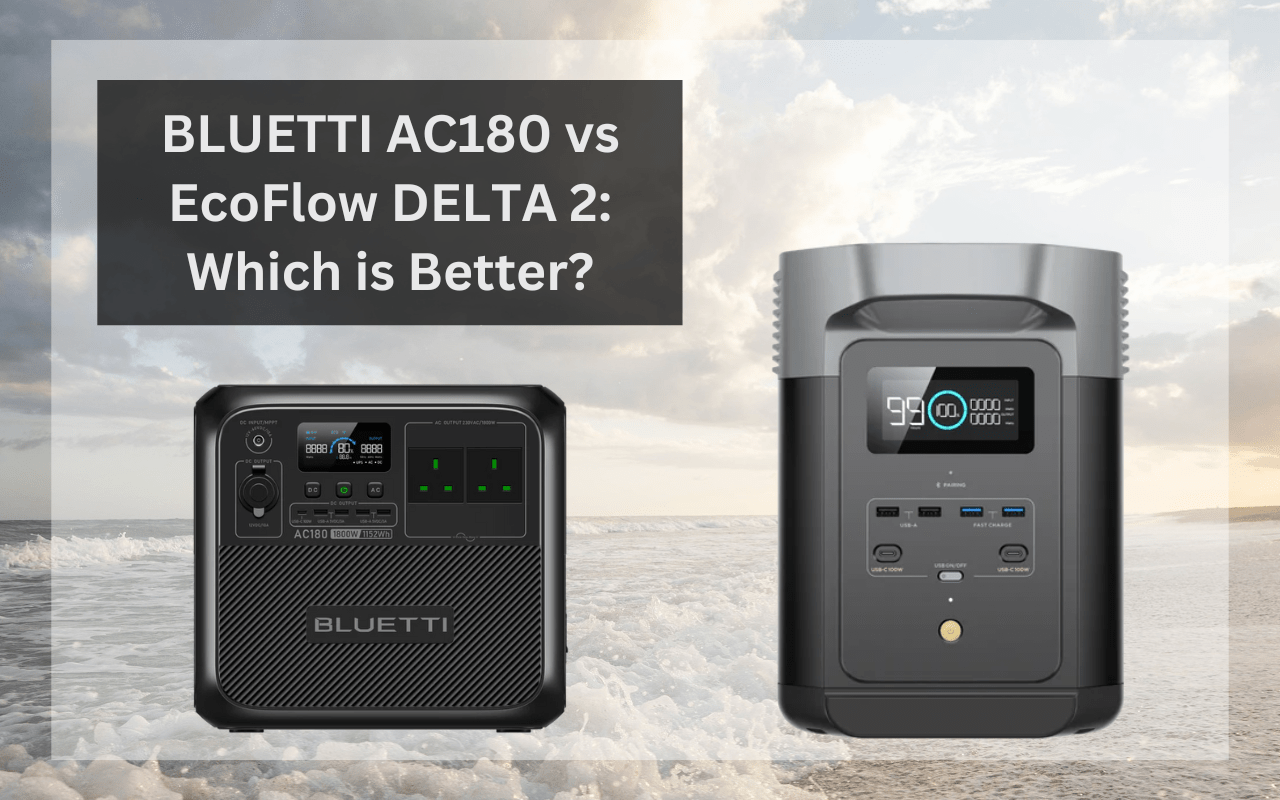
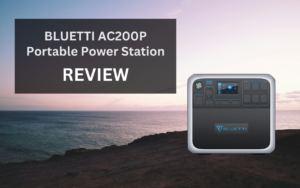
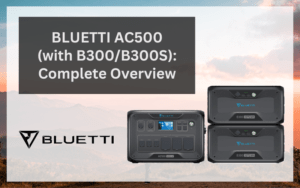
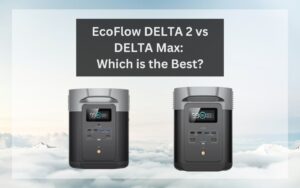
Pingback: EcoFlow vs Bluetti Charging Speeds: How Do They Compare?